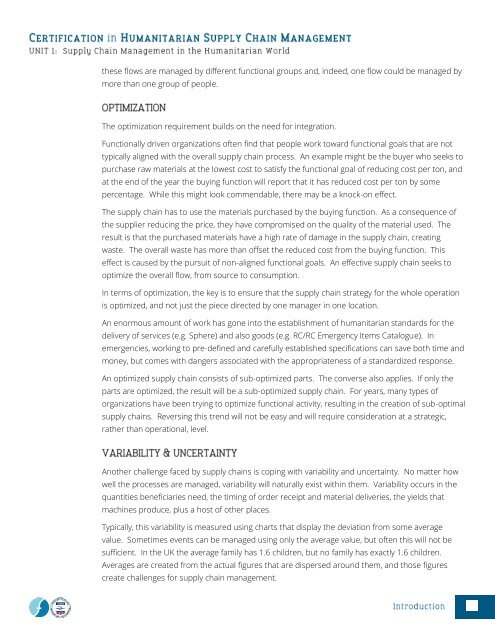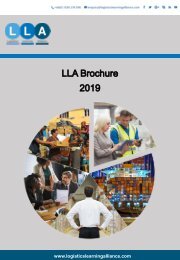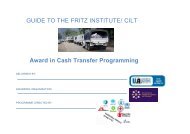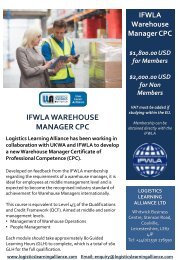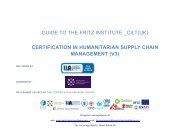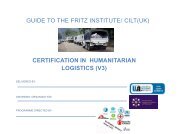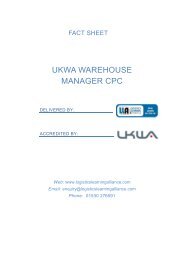CHSCM 3.0 - Unit 1 - SCM in the Humanitarian World
Learning Materials for Unit 1 of the Certification in Humanitarian Supply Chain Management (CHSCM).
Learning Materials for Unit 1 of the Certification in Humanitarian Supply Chain Management (CHSCM).
Create successful ePaper yourself
Turn your PDF publications into a flip-book with our unique Google optimized e-Paper software.
<strong>the</strong>se flows are managed by different functional groups and, <strong>in</strong>deed, one flow could be managed by<br />
more than one group of people.<br />
The optimization requirement builds on <strong>the</strong> need for <strong>in</strong>tegration.<br />
Functionally driven organizations often f<strong>in</strong>d that people work toward functional goals that are not<br />
typically aligned with <strong>the</strong> overall supply cha<strong>in</strong> process. An example might be <strong>the</strong> buyer who seeks to<br />
purchase raw materials at <strong>the</strong> lowest cost to satisfy <strong>the</strong> functional goal of reduc<strong>in</strong>g cost per ton, and<br />
at <strong>the</strong> end of <strong>the</strong> year <strong>the</strong> buy<strong>in</strong>g function will report that it has reduced cost per ton by some<br />
percentage. While this might look commendable, <strong>the</strong>re may be a knock-on effect.<br />
The supply cha<strong>in</strong> has to use <strong>the</strong> materials purchased by <strong>the</strong> buy<strong>in</strong>g function. As a consequence of<br />
<strong>the</strong> supplier reduc<strong>in</strong>g <strong>the</strong> price, <strong>the</strong>y have compromised on <strong>the</strong> quality of <strong>the</strong> material used. The<br />
result is that <strong>the</strong> purchased materials have a high rate of damage <strong>in</strong> <strong>the</strong> supply cha<strong>in</strong>, creat<strong>in</strong>g<br />
waste. The overall waste has more than offset <strong>the</strong> reduced cost from <strong>the</strong> buy<strong>in</strong>g function. This<br />
effect is caused by <strong>the</strong> pursuit of non-aligned functional goals. An effective supply cha<strong>in</strong> seeks to<br />
optimize <strong>the</strong> overall flow, from source to consumption.<br />
In terms of optimization, <strong>the</strong> key is to ensure that <strong>the</strong> supply cha<strong>in</strong> strategy for <strong>the</strong> whole operation<br />
is optimized, and not just <strong>the</strong> piece directed by one manager <strong>in</strong> one location.<br />
An enormous amount of work has gone <strong>in</strong>to <strong>the</strong> establishment of humanitarian standards for <strong>the</strong><br />
delivery of services (e.g. Sphere) and also goods (e.g. RC/RC Emergency Items Catalogue). In<br />
emergencies, work<strong>in</strong>g to pre-def<strong>in</strong>ed and carefully established specifications can save both time and<br />
money, but comes with dangers associated with <strong>the</strong> appropriateness of a standardized response.<br />
An optimized supply cha<strong>in</strong> consists of sub-optimized parts. The converse also applies. If only <strong>the</strong><br />
parts are optimized, <strong>the</strong> result will be a sub-optimized supply cha<strong>in</strong>. For years, many types of<br />
organizations have been try<strong>in</strong>g to optimize functional activity, result<strong>in</strong>g <strong>in</strong> <strong>the</strong> creation of sub-optimal<br />
supply cha<strong>in</strong>s. Revers<strong>in</strong>g this trend will not be easy and will require consideration at a strategic,<br />
ra<strong>the</strong>r than operational, level.<br />
Ano<strong>the</strong>r challenge faced by supply cha<strong>in</strong>s is cop<strong>in</strong>g with variability and uncerta<strong>in</strong>ty. No matter how<br />
well <strong>the</strong> processes are managed, variability will naturally exist with<strong>in</strong> <strong>the</strong>m. Variability occurs <strong>in</strong> <strong>the</strong><br />
quantities beneficiaries need, <strong>the</strong> tim<strong>in</strong>g of order receipt and material deliveries, <strong>the</strong> yields that<br />
mach<strong>in</strong>es produce, plus a host of o<strong>the</strong>r places.<br />
Typically, this variability is measured us<strong>in</strong>g charts that display <strong>the</strong> deviation from some average<br />
value. Sometimes events can be managed us<strong>in</strong>g only <strong>the</strong> average value, but often this will not be<br />
sufficient. In <strong>the</strong> UK <strong>the</strong> average family has 1.6 children, but no family has exactly 1.6 children.<br />
Averages are created from <strong>the</strong> actual figures that are dispersed around <strong>the</strong>m, and those figures<br />
create challenges for supply cha<strong>in</strong> management.


